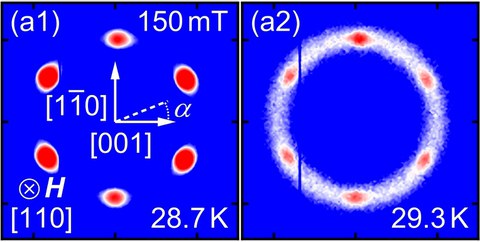28.05.2020
Forschung: Schwache Kristallisation fluktuierender Skyrmion-Texturen in MnSi
Ein Kristall besteht in der Regel aus Atomen oder Ionen, die auf einem regelmäßigen Gitter angeordnet sind. Der Kristall bildet sich in einem Kristallationsprozess aus einer Flüssigkeit, wenn die Temperatur unter eine kritische Temperatur sinkt. Der Kristallisations-Phasenübergang ist normalerweise stark erster Ordnung, kann jedoch in bestimmten Fällen schwach erster Ordnung oder sogar zweiter Ordnung sein. Dann wird durch die Theorie der schwachen Kristallisation vorhergesagt, dass räumliche Anordnungen mit gleichseitigen Dreiecken bevorzugt werden, z.B. bei kubisch raumzentrierten Kristallen.
Effektive Kristalle findet man in chiralen Magneten wie MnSi, bei denen die Magnetisierung räumlich in periodischer Weise variiert. Insbesondere existieren zweidimensionale magnetische Kristalle bestehend aus Dreicksgittern von Skyrmionen -- dies sind topologische Texturen der Magnetisierung, die durch eine Windungszahl gekennzeichnet sind. Die Skyrmiongitter-Phase ist von der paramagnetische Phase durch einen Übergang getrennt, der schwach erster Ordnung ist. Eine wichtige Frage betrifft die Art dieses Phasenübergangs: Erscheint das Skyrmionengitter plötzlich aus der paramagnetische Phase? Oder bilden sich die Skyrmionen zuerst und kristallisieren anschließend zu einem Gitter? Forscher des SFB 1143, in Zusammenarbeit mit der experimentellen Arbeitsgruppe von Christian Pfleiderer von der TU München, bringen bezüglich dieser Frage Licht ins Dunkel. Beweise für Dreieckskorrelationen in der paramagnetischen Phase von MnSi wurden in Neutronenstreuexperimenten gefunden, die auf eine Bildung von Skyrmionen oberhalb des Phasenübergangs hinweisen.
J. Kindervater, I. Stasinopoulos, A. Bauer, F. X. Haslbeck, F. Rucker, A. Chacon, S. Mühlbauer, C. Franz, M. Garst, D. Grundler, C. Pfleiderer,
Weak crystallization of fluctuating skyrmion textures in MnSi,
Phys. Rev. X 9, 041059 (2019) (arXiv)

